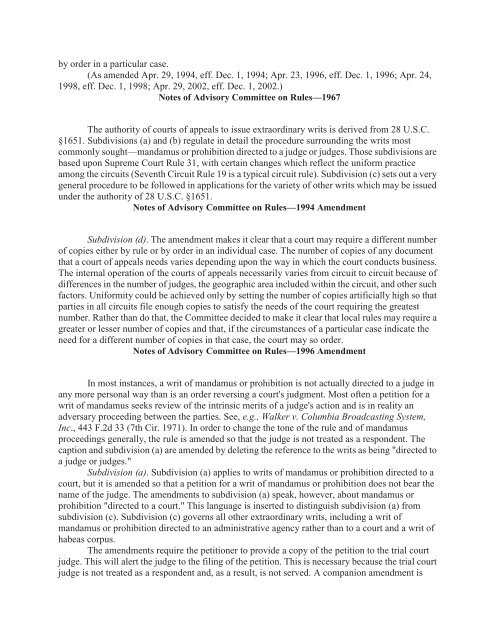Federal Rules of Appellate Procedure 2014-2015, 2014a
Federal Rules of Appellate Procedure 2014-2015, 2014a
Federal Rules of Appellate Procedure 2014-2015, 2014a
You also want an ePaper? Increase the reach of your titles
YUMPU automatically turns print PDFs into web optimized ePapers that Google loves.
y order in a particular case.<br />
(As amended Apr. 29, 1994, eff. Dec. 1, 1994; Apr. 23, 1996, eff. Dec. 1, 1996; Apr. 24,<br />
1998, eff. Dec. 1, 1998; Apr. 29, 2002, eff. Dec. 1, 2002.)<br />
Notes <strong>of</strong> Advisory Committee on <strong>Rules</strong>—1967<br />
The authority <strong>of</strong> courts <strong>of</strong> appeals to issue extraordinary writs is derived from 28 U.S.C.<br />
§1651. Subdivisions (a) and (b) regulate in detail the procedure surrounding the writs most<br />
commonly sought—mandamus or prohibition directed to a judge or judges. Those subdivisions are<br />
based upon Supreme Court Rule 31, with certain changes which reflect the uniform practice<br />
among the circuits (Seventh Circuit Rule 19 is a typical circuit rule). Subdivision (c) sets out a very<br />
general procedure to be followed in applications for the variety <strong>of</strong> other writs which may be issued<br />
under the authority <strong>of</strong> 28 U.S.C. §1651.<br />
Notes <strong>of</strong> Advisory Committee on <strong>Rules</strong>—1994 Amendment<br />
Subdivision (d). The amendment makes it clear that a court may require a different number<br />
<strong>of</strong> copies either by rule or by order in an individual case. The number <strong>of</strong> copies <strong>of</strong> any document<br />
that a court <strong>of</strong> appeals needs varies depending upon the way in which the court conducts business.<br />
The internal operation <strong>of</strong> the courts <strong>of</strong> appeals necessarily varies from circuit to circuit because <strong>of</strong><br />
differences in the number <strong>of</strong> judges, the geographic area included within the circuit, and other such<br />
factors. Uniformity could be achieved only by setting the number <strong>of</strong> copies artificially high so that<br />
parties in all circuits file enough copies to satisfy the needs <strong>of</strong> the court requiring the greatest<br />
number. Rather than do that, the Committee decided to make it clear that local rules may require a<br />
greater or lesser number <strong>of</strong> copies and that, if the circumstances <strong>of</strong> a particular case indicate the<br />
need for a different number <strong>of</strong> copies in that case, the court may so order.<br />
Notes <strong>of</strong> Advisory Committee on <strong>Rules</strong>—1996 Amendment<br />
In most instances, a writ <strong>of</strong> mandamus or prohibition is not actually directed to a judge in<br />
any more personal way than is an order reversing a court's judgment. Most <strong>of</strong>ten a petition for a<br />
writ <strong>of</strong> mandamus seeks review <strong>of</strong> the intrinsic merits <strong>of</strong> a judge's action and is in reality an<br />
adversary proceeding between the parties. See, e.g., Walker v. Columbia Broadcasting System,<br />
Inc., 443 F.2d 33 (7th Cir. 1971). In order to change the tone <strong>of</strong> the rule and <strong>of</strong> mandamus<br />
proceedings generally, the rule is amended so that the judge is not treated as a respondent. The<br />
caption and subdivision (a) are amended by deleting the reference to the writs as being "directed to<br />
a judge or judges."<br />
Subdivision (a). Subdivision (a) applies to writs <strong>of</strong> mandamus or prohibition directed to a<br />
court, but it is amended so that a petition for a writ <strong>of</strong> mandamus or prohibition does not bear the<br />
name <strong>of</strong> the judge. The amendments to subdivision (a) speak, however, about mandamus or<br />
prohibition "directed to a court." This language is inserted to distinguish subdivision (a) from<br />
subdivision (c). Subdivision (c) governs all other extraordinary writs, including a writ <strong>of</strong><br />
mandamus or prohibition directed to an administrative agency rather than to a court and a writ <strong>of</strong><br />
habeas corpus.<br />
The amendments require the petitioner to provide a copy <strong>of</strong> the petition to the trial court<br />
judge. This will alert the judge to the filing <strong>of</strong> the petition. This is necessary because the trial court<br />
judge is not treated as a respondent and, as a result, is not served. A companion amendment is


















